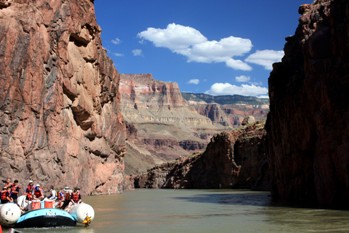
CONVERSION
The first sign of conversion came at mile 64 when the Great Angular Unconformity hove into view. This chronological gap between the Tapeats Sandstone and the approximately 1100 Million year-old Dox Sandstone was not to be missed, so I begged the guide to let me climb the short way up the cliff to the exposure. To my amazement, two Scouts scrambled up with me, eager to have their photo taken with 550 million years in the span of their hand. Two down, twenty to go. Happily, as soon as I started talking to them about schists, cleavage and dykes – something I clearly should have done earlier - everyone took notice.
Our remaining days in the Canyon were spent sometimes hanging on for dear life through rapids, sometimes on long lazy stretches, just gazing at the staircase of terraces rising above us. We hiked into slot-canyons, bathed in the turquoise waters of Havasu Creek, visited ancient native ruins perched on cliff tops at night. Geology was a regular topic of conversation, but even though every Scout had been taught Earth science before high school, I found a profound lack of what might be called “geo-literacy”.
One Scout thought that the Colorado River had been responsible for all the rocks in the canyon, from the Vishnu schist to the Kaibab Limestone. The concept of continents being born, mountains rising, rivers flowing, continents dying and breaking up, over and over again was just too vast for his understanding. Most had real trouble with time periods – thousands, millions and billions seemed to be interchangeable, as if they all represented a single quantity: “lots”. One of the other adult leaders commented that if the seas had come up and gone down over geological time then it shows there is no need to blame man for global warming now…
Perhaps the most disturbing conversation I had was with an adult leader. “Do you really believe in science? I mean do you think there is a religious explanation for this, or are you a full-on scientist?” I gave my usual comment that science and religion don’t occupy the same territory. Science is evidence-based and faith is not. I believe evidence.